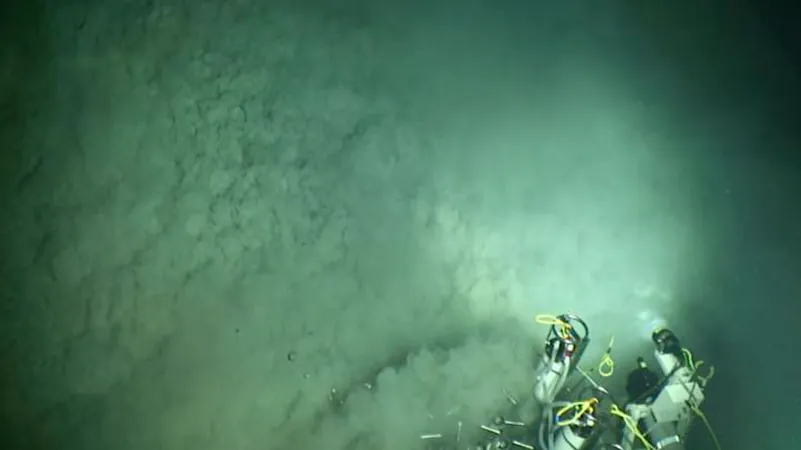
Unveiling the Secrets Below: First-Ever Global Appraisal of Subsurface Microbiomes
2024-12-19
Author: Wei Ling
An Unexplored Microbial World
Researchers at the Marine Biological Laboratory (MBL) in Woods Hole have delved into the enigmatic world beneath our feet, unveiling astonishing findings about the microbial ecosystems that thrive in the Earth’s subsurface environments, including unexplored niches in gold mines, aquifers, and deep-sea boreholes. This groundbreaking study is the first of its kind to globally assess these hidden microbial communities, and it unveils incredible microbial diversity that rivals, or perhaps even surpasses, that found on the Earth’s surface.
Diversity in the Depths
Led by MBL Associate Scientist Emil Ruff, the extensive eight-year study highlights that some subsurface environments harbor a remarkable variety of microbes, thriving even at depths of 491 meters below the seafloor and up to 4,375 meters underground. This discovery not only shines a light on the richness of microbial life hidden away from sunlight but also opens doors for bioprospecting new compounds and medicinal resources. Furthermore, it significantly contributes to our understanding of how organisms adapt to extreme low-energy environments—information that could even illuminate the search for extraterrestrial life.
Challenging Traditional Assumptions
Traditionally, scientists assumed that microbial life diminishes in diversity as one descends deeper into the Earth due to a lack of energy. However, Ruff’s findings challenge this premise, suggesting that certain subsurface ecosystems may sustain high levels of diversity, especially among marine microbes and those within the Archaea domain. The study starkly contrasts microbial communities between marine and terrestrial habitats, revealing distinct ecological divides driven by varying selective pressures in each environment.
Ecological Divides and Evolutionary Adaptations
An interesting parallel emerges - just as few land-based plants and animals successfully adapt to both marine and terrestrial environments, microbial communities also exhibit significant differences in composition across these realms, despite their comparable levels of diversity. This raises intriguing questions about evolutionary adaptations and the resilience of life in varied environments.
Methodological Insights
The groundbreaking research utilized standard methodologies to analyze over 1,000 microbial DNA samples from 50 different marine and terrestrial ecosystems, providing a cohesive dataset for comparison. This wide-ranging effort not only reveals the vastness of microbial life beneath our feet but also leads to exciting implications for broader scientific fields, including astrobiology. If Mars once possessed liquid water, the conditions below its surface could mirror those on Earth, offering insights into the potential for life beyond our planet.
Adaptability and Timescales
Interestingly, the study reveals that microbes in these low-energy subsurface environments operate on drastically different timescales. Some of the cellular life forms in these depths are estimated to divide once every 1,000 years, emphasizing the remarkable adaptability of life under such extreme conditions. Researchers speculate that understanding these organisms could offer groundbreaking insights into aging and efficiency in energy use—lessons that could be applied in a multitude of scientific and industrial applications.
Significance and Future Implications
This robust study, with its revelations about subterranean life, and its contributions to developing bioinformatics techniques, positions itself as a significant milestone in our understanding of microbial diversity. With the potential to change the way we view life and its adaptability on Earth—and perhaps beyond—this research underscores the importance of continued exploration and understanding of the hidden ecosystems that lie beneath the Earth’s surface.
A Hopeful Outlook for Astrobiology
As science moves forward, the implications of this research beckon not just curiosity, but a hopeful glance toward discovering life in the dark, distant corners of our universe. Notably, the future of astrobiology may well hinge on the lessons learned from the resilient, diverse microbes that call the depths of our planet home.




 Brasil (PT)
Brasil (PT)
 Canada (EN)
Canada (EN)
 Chile (ES)
Chile (ES)
 España (ES)
España (ES)
 France (FR)
France (FR)
 Hong Kong (EN)
Hong Kong (EN)
 Italia (IT)
Italia (IT)
 日本 (JA)
日本 (JA)
 Magyarország (HU)
Magyarország (HU)
 Norge (NO)
Norge (NO)
 Polska (PL)
Polska (PL)
 Schweiz (DE)
Schweiz (DE)
 Singapore (EN)
Singapore (EN)
 Sverige (SV)
Sverige (SV)
 Suomi (FI)
Suomi (FI)
 Türkiye (TR)
Türkiye (TR)